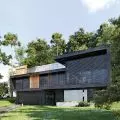"Fertile Futures," the official representation of Portugal, centers around the problem of fresh water, which is not only a natural element, but also an economic and political one. The pavilion's creators are calling for a discussion on the protection of this important resource. For Egypt, too, water is an important point of reference - the ancient Nile River became a "Laboratory of the Future" for a team of scientists, engineers and architects who worked on research and studies on the relationship between nature, landscapes and cultures in the region. The Denmark Pavilion analyzed the resources and extent of destruction of coastal areas in the Copenhagen area, and presented projects proposing ecological solutions. Similarly, though from a different angle, the theme of water was addressed by a team from the Netherlands Pavilion, including a series of drawings "The Waterworks of Money" by researcher and cartographer Carlijna Kingma in the exhibition "Plumbing the System," which refers to architecture as an expression of the flow of systems: economic, social and political.
Philippine Pavilion - "Tripa de Gallina: Guts of Estuary," curated by Sam Domingo, Choie Y. Funk
photo: Marco Zorzanello
earthy, otherworldly and otherworldly
A group of architects, designers and artists from The Dry Collective are the curators of the Finnish Pavilion, who have declared "the death of the flush toilet as we know it" and presented a very simple and basic thing - the Huussi bio toilet. This is also an important aspect of sustainability and fertilizer and waste management. And for the Spanish Pavilion team, which presented the "Foodscapes" exhibition, the connection between agriculture and architecture in the production of food for cities and the world became a starting point for thinking about sustainability and planning.
Spanish Pavilion - "Foodscapes," curated by Eduardo Castillo-Vinuesa, Manuel Ocaña del Valle
photo: Matteo de Mayda
The films on display show the often brutal reality of food production and disposal. "At a time when energy debates are more important than ever, food remains in the background, yet the way we produce, distribute and consume it mobilizes our societies, shapes our metropolises and transforms our geographic areas more radically than any other energy source," notes one of the curators, Eduardo Castillo-Vinuesa. Our absurd world is well defined by a quote from a video by the creators of the exhibition at the Spanish Pavilion: "Every atom of which you are composed was once a landscape under the sky."
Finnish Pavilion - "Huussi, Imagining the Future History of Sanitation," curated by Arja Renell, The Dry Collective
Photo: Matteo de Mayda
Space is another direction where (with their eyes) architects are reaching. The Luxembourg pavilion, with the "Down to Earth" exhibition by curators Francelle Cane and Marija Marić, turns into a lunar landscape and focuses on the potential of celestial bodies, planets and the moon, but also their exploitation and space mining. Cyprus, on the other hand, in a pavilion outside the Biennale grounds, offers a journey to Mars with symbolic representatives of the Neolithic Chirokitia community, who were probably also explorers.
Luxembourg Pavilion - "Down to Earth," curated by Francelle Cane, Marija Marić
Photo: Marco Zorzanello
Denmark Pav ilion - "Coastal Imaginaries," curator: Josephine Michau
photo: Matteo de Mayda
erroneous data and lack of access
The Polish Pavilion features a project titled "Datament" by artist Anna Barlik, architect Marcin Strzała and curator Jacek Sosnowski. It is intended to serve as a contribution to the discussion of physical and digital architecture, based on the thesis that databases can contain errors [cf. A&B 6/2023]. The installation that fills the pavilion is a physical manifestation of errors made at a scale of 1:1.The metal frames with a grid are models of four houses from different countries, whose dimensions turn out to be false, because they are based on falsified data. Physically, the installation is associated with the project "Emergency Exit" by Agnieszka Kurant and Aleksandra Wasilkowska at the 2010 Architecture Biennale, although in a less poetic form and simplified, schematically treated content, like an Excel diagram.
Polish Pavilion - "Datament," curator: Jacek Sosnowski
photo: Matteo de Mayda
Venice residents have had a problem for years, not only with tourists who turn the city into their vanity market during the various Biennales, but also with access to the Giardini grounds, as the Biennale institution appropriates more and more city land for its own purposes. This year, the creators of the exhibition in the Austrian Pavilion wanted to give area residents access to parts of the Giardini via a bridge, but Venice authorities did not agree to such folly. The pavilion's curators, AKT and Hermann Czech, invited residents to join them, and so an alternative Biennale and Unfolding Pavilion was created outside the Giardini. When you don't have access, places can be ignored, boycotted, taken over or alternatively organized, adding your voice to the debate.
Egypt Pav ilion - "NiLab - The Nile as Laboratory," curated by Ahmed Sami Abd Elrahman, Marina Tornatora, Ottavio Amaro, Ghada Farouk, Moataz Samir
Photo: Matteo de Mayda
twilight of STARchitects
Interestingly, at this year's Biennale, the absence of star architects, the wealthy offices from developed countries that dominated the Biennale in previous editions, is evident. This is a refreshing change. Yes, Lord Foster with his foundation (and Holcim company) appeared as well, presenting a pavilion, an emergency shelter that, according to press reports, is expected to revolutionize housing after natural disasters or to help in humanitarian crises. Lord Foster's megalomania doesn't change - such a house could be produced in large quantities and simply serve people in crises, it doesn't have to revolutionize right away. The pavilion can be seen in the Marinaressa gardens, next to the Giardini.
Austrian Pavilion - "Participation," curated by AKT collective, Hermann Czech
photo: Matteo de Mayda
This year's Biennale awards, therefore, did not go to "white old architects." An international (and diverse) jury selected by Lesley Lokko awarded the Venice Lions and several honorable mentions. The Golden Lion for best national pavilion went this year to Brazil for the exhibition "Terra," created by Gabriela de Matos and Paulo Tavares. It's a sensual exhibition in an earth-filled pavilion that is dedicated to the sins of colonization and reparations for Brazil's indigenous and black populations. It responds perfectly to the Biennale's motto - decolonization. To commend the former colonial empire for its good practices, a special mention was given to the exhibition "Dancing Before the Moon" (authors Jayden Ali, Joseph Henry, Meneesha Kellay and Sumitra Upham) at the UK Pavilion "for its curatorial strategy and design proposals celebrating the power of everyday rituals as forms of resistance and spatial practices in diasporic communities."
The Golden Lion for best national pavilion went this year to Brazil for the exhibition "Terra"; pictured are the authors (from left): Paulo Tavares and Gabriela de Matos
Photo: Andrea Avezzù
The Golden Lion for the best project in the main exhibition, curated by Lokko, went to the project "Ente di Decolonizzazione, Borgo Rizza" by Sandi Hilal and Alessandro Petti ofDAAR - Decolonizing Architecture Art Research (Stockholm/Bethlehem) for their long-standing commitment to the politics and architectural and educational practices of decolonization in Palestine and Europe. The Golden Lion Lifetime Achievement Award went to Nigerian-born artist and architect Demas Nwoko. Also of Nigerian origin and based in New York, young artist Olalekan Jeyifous received the Silver Lion "for a multimedia installation that explores world-building practices, broadens public perspectives and imagination, offering visions of a decolonized and decarbonized future," on view at the Giardini Central Pavilion.
The Golden Lion for the best project in the main exhibition was awarded to Sandi Hilal and Alessandro Petti (DAAR) for their project "Ente di Decolonizzazione, Borgo Rizza"
Photo: Andrea Avezzù
Three special awards went to the artists participating in the main exhibition: Twenty Nine Studio / Sammy Baloji "for a three-part installation that explores the past, present and future of the Democratic Republic of Congo through excavations of colonial architectural archives"; Wolff Architects "for an installation that reflects collaborative and multimodal design practices, as well asas well as a nuanced and imaginative approach to resources, research and representation," and Thandi Loewenson "for a militant research practice that materializes spatial histories of land struggles, mining and liberation using graphite and speculative writing as design tools."
The Golden Lion Lifetime Achie vement Award went to Nigerian-born artist and architect Demas Nwoko
Photo: Jacopo Salvi
The world is changing, our culture and architecture must also follow trends and social changes - ecology, the digital revolution or the debate about colonialism. Going beyond the schemes of current knowledge and science, beyond the pages of academy books, beyond the norms of architectural theory and beyond Excel tables reveals an infinite plane of imagination, yet a winding road in this convoluted and diverse world, rushing in every direction. By looking outside the box and from different perspectives, we can help ourselves find the right ideas, new or old forms and tools to create a better world, a better world for all of us, not just for the global north or global south, east or west. We all live on the same planet.
The Venice Architecture Biennale is definitely worth seeing, two days are not enough, especially since there are many accompanying events and exhibitions throughout the city.
Unfolding Pavilion - created on the initiative of the curators of the Austrian Pavilion and in cooperation with the locals, the alternative grounds of the Biennale (#openGiardini)
photo: Laurian Ghinițoiu
Anna KRENZ
Illustrations provided courtesy of the organizers of La Biennale di Venezia.









































































